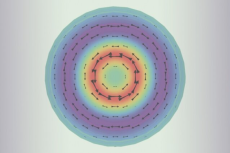An Integral Role for Gluons in the Proton's Pressure Distribution

Pressure forces in the center of the neutron push outward while the outer portions push inward. Credit: Massachusetts Institute of Technology
Science Achievement
For the first time, lattice quantum chromodynamics (LQCD) calculations run at Lawrence Berkeley National Laboratory’s National Energy Research Scientific Computing Center (NERSC) allowed nuclear physicists from the Massachusetts Institute of Technology (MIT) to determine the pressure distribution inside a proton, including the individual contributions of the proton’s fundamental particles: quarks and gluons. This discovery brings nuclear scientists closer to a complete understanding of a proton’s structure and the fundamental particles that make up most of the visible matter in the universe.
Significance and Impact
Experiments at Thomas Jefferson National Laboratory recently determined the remarkable result that the internal pressure in a proton is greater than that in the interior of a neutron star. However, experiments are unable to determine the individual contributions to this pressure from quarks and gluons, so theorists turn to large scale-calculations to identify the individual importance of each component. The results of this research, published earlier this year in Physical Review Letters and featured on the journal cover, show that gluons are integral to the pressure distribution inside the proton, revealing that the gluon contribution is actually larger than and quite different from that of the quarks. The researchers combined their LQCD results with calculations of the quark contributions to determine fundamental aspects of the proton pressure distribution.
These results showed two distinct regions of the pressure distribution: near the center of the proton there is a repulsive pressure, and near the exterior of the proton there is a confining pressure. The proton needs this positive/negative structure to maintain its stability. These calculations showed that gluons had a higher probability of being further from the center of the proton than quarks do.
Research Details
Quarks and gluons are the fundamental particles that form the complex structure of the proton, but until now scientists have been able to discern much more about quarks than gluons. Since quarks carry an electric charge, they can be studied using electron scattering experiments. Gluons don’t carry electric charge and have been much more difficult to research. However, plans for a new type of accelerator, an electron ion collider, would allow the gluonic structure of protons to be probed in much greater depth.
Scientists’ computational models create snapshots of what the quarks and gluons are doing inside a proton. From those snapshots, researchers are then able to extract the physics they’re seeking. “The task of creating those snapshots is a very computationally demanding one,” said William Detmold, an associate professor at MIT who co-led this research. “What we are calculating is what an observer would see if they jumped inside a proton.”
NERSC’s Cori supercomputer was instrumental to this research. “It was a massive, large-scale computational task, both in terms of simulation and data analysis,” said Phiala Shanahan, an Assistant Professor of Physics at MIT and the study’s lead author. “Our calculations need to run on many nodes at once; it would not have been possible to do these calculations using smaller resources.”
Related Links
https://phys.org/news/2019-02-physicists-proton-pressure.html
Shanahan, P. E.; Detmold, W., "Pressure Distribution and Shear Forces inside the Proton"; PHYSICAL REVIEW LETTERS, 122 2019 FEB 22, 10.1103/PhysRevLett.122.072003
About NERSC and Berkeley Lab
The National Energy Research Scientific Computing Center (NERSC) is a U.S. Department of Energy Office of Science User Facility that serves as the primary high performance computing center for scientific research sponsored by the Office of Science. Located at Lawrence Berkeley National Laboratory, NERSC serves almost 10,000 scientists at national laboratories and universities researching a wide range of problems in climate, fusion energy, materials science, physics, chemistry, computational biology, and other disciplines. Berkeley Lab is a DOE national laboratory located in Berkeley, California. It conducts unclassified scientific research and is managed by the University of California for the U.S. Department of Energy. »Learn more about computing sciences at Berkeley Lab.







